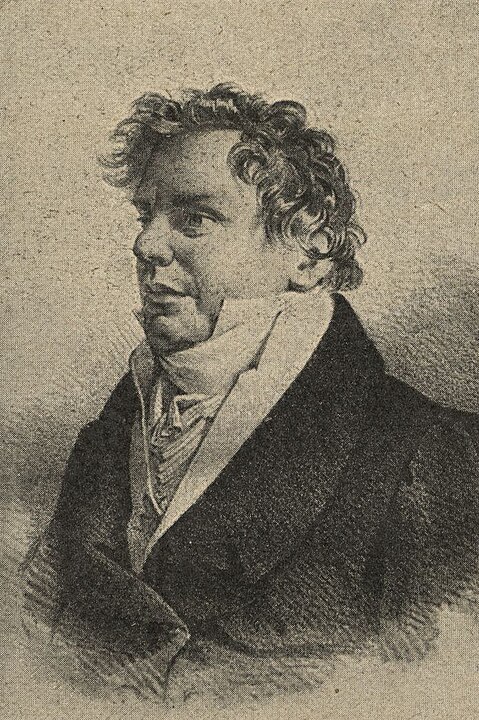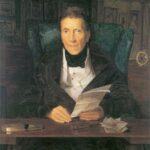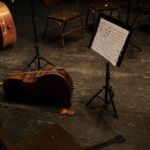Schuppanzigh (1776-1830) was Beethoven’s violin teacher, friend and lifelong champion from the composer’s arrival in Vienna until his passing. He rehearsed and performed the string quartets and played at the premiere of every symphony Beethoven composed.
In this article, you will read about the relationship between Schuppanzigh and Beethoven, how the composer would mercilessly tease his friend about his weight, and their pivotal partnership in the in re-making of the string quartet as a medium.
Schuppanzigh’s musical legacy
We can thank Schuppanzigh for the establishment of the first professional string quartet in Europe, and the first ever public performances on a subscription basis. To Beethoven, he was indispensable, allowing the composer to fine-tune his compositions through dedicated rehearsal. This is particularly true for the Late Quartets, the final six Beethoven composed, which are widely regarded as some of the greatest compositions ever written.
Schuppanzigh’s early life and career
Son of an Italian professor, Ignaz Schuppanzigh was born in Vienna in 1776. Handsome as a young man, in his adult years he became morbidly obese, a fact Beethoven relentlessly teased him for, as did Viennese popular culture, evidenced by a caricature that remains illustrating his corpulent frame.
Swapping the viola for the violin early on, by the age of 21, Schuppanzigh had become both a virtuoso musician and a conductor. He married Barbara Killitschky, a goldworker’s daughter and secured himself a comfortable and reliable income as a private musician.
Schuppanzigh played as Prince Lichnowsky’s house violinist and in his informal private string quartet from 1795. The Linchowsky’s regular musicales brought together great talent and patronage, and this is where Beethoven discovered Schuppanzigh’s considerable abilities as a violinist. They became friends for life and worked closely together for over two decades. When Haydn, Beethoven’s teacher left for the second time to London in 1794, the composer ended up with some free time, so he took up violin lessons with Schuppanzigh.
Beethoven’s first string quartets of 1800 (commissioned by his patron Prince Lobkowitz) were premiered by Schuppanzigh’s quartet. His next ensemble formed in 1808, commissioned by Prince Razumovsky. This string quartet was unique in that it was a permanent arrangement with contracts for life for the musicians. It only lasted eight years, however, due to the destruction of the Razumovsky palace by a fire. The members of this quartet were Louis Sina, on second violin, Franz Weiss on viola and Joseph Linke on cello.
The French occupation of Vienna saw Schuppanzigh leave the city for St. Petersburg in 1816, to return seven years later. Upon coming home he reformed the quartet, with a new member on second violin: Karl Holz.
Beethoven and Schuppanzigh’s relationship
It is not known for how long Beethoven took lessons from Schuppanzigh, however, their friendship endured and they formed a musical partnership at the time the composer was creating his remarkable string quartets. Beethoven’s quartets, in particular, the late pieces were technique-wise significantly more challenging than any written before by other composers. Dedicated rehearsals were needed and Schuppanzigh and his fellow musicians were not always successful in satisfying the legendary composer’s extremely high standards. In response to a complaint by the quartet leader about a difficult passage in the score, Beethoven reportedly said:
‘Do you believe that I think about your miserable fiddle when the muse strikes me?’
Some of the technical difficulties in Beethoven’s string quartets include complex runs that are played in synchrony by two or more musicians, or cross-rhythms and challenging harmonies. Beethoven begun work on his final quartets in 1824, 14 years after the last he had produced. Haydn is often referred to as the ‘father’ of both the symphony and the string quartet, however, Beethoven made both mediums more ambitious, more personal and expressive and far more varied.
Beethoven often used nicknames for the people in his life. These were sometimes a simple play on words or a name intended to mock the individual, as was the case with Schuppanzigh. The composer liked to call him Sir John Falstaff, who was a character in some of Shakespeare’s plays, a rather large, heavy-drinker. Schuppanzigh would often complain about climbing four floors to reach Beethoven’s apartment, and in a letter, Beethoven wrote:
‘As soon as my machine is finished which will be able to transport you quite leisurely up to me on the fourth floor, I will let you know.’
The teasing didn’t stop there! In 1801, Beethoven wrote a choral piece for Schuppanzigh titled: ‘In Praise of the Fat One’!
As a performer, he treated the violinist as a servant of his will. Their musical partnership was not conflict free, however, their association and friendship proved to be steadfast. When Schuppanzigh returned from seven years in St. Petersburg, Beethoven composed him a short canon (Wo0 184) to celebrate his return.
Schuppanzigh was one of the torchbearers at Beethoven’s funeral, amongst composers and musicians such as Franz Schubert and Carl Czerny.
What did Schuppanzigh’s peers say about him?
Formerly one of Beethoven’s students, the Austrian composer and teacher Carl Cerny described Schuppanzigh as:
‘a short, fat, pleasure-loving young man…one of the best violin-players of that time…unrivaled in quartet playing, a very good concert artist and the best orchestra conductor of his day. No one knew how to enter into the spirit of this music better than he.”
The composer Johann Friedrich Reichardt also praised Schuppanzigh for his flowing and melodious playing style.
The biggest praise of all, however, and proof of his great talent as a musician is evident in the decades spent by Beethoven’s side, working tirelessly to perform the great string quartets as the legendary composer intended them to be played.
A.K.












